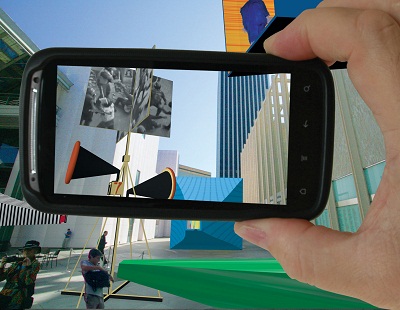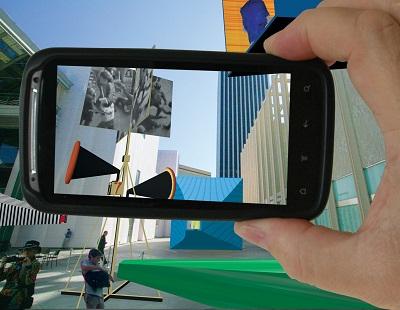This weekend as part of our Artist’s Respond series, we launched Project-o-Rator, by Will Pappenheimer and John Craig Freeman. The project transforms the in-between spaces on the museum campus using augmented reality.

Here’s how it works:
On your smartphone, go to http://project-o-rators.thruhere.net. If you do not have the free augmented reality browser Layar installed, you'll be prompted to install the app. Within Layar, search for "LACMA" to launch the project.
-or-
Use the QR code below to install the free Layar Augmented Reality Browser, which will launch the project.
-or-
Download Layar at http://layar.com and search for “LACMA”.

You’ll want to be in the outdoor public spaces at the museum in order to experience the project. By viewing the plaza spaces through the camera on your mobile device, you’ll encounter an augmented reality layer that introduces three-dimensional virtual objects in your field of vision. Interacting with those objects, you’ll encounter associated sound and images.
Got that? Okay, now here is what Will and Craig, who are part of an artist collection called Manifest.AR, had to say about the project:
Will: We got interested in augmented reality via working with online open gaming. We have an ongoing interest in a mixed reality space. We view augmented reality as a new form of public art.
Craig: I was inspired by the campus at LACMA, the space between the buildings that creates this kind of public square. And further, by the early Russian avant-garde and the work of Gustav Klutsis in particular. I’ve always been drawn to the rostrums and propaganda stands he was designing in 1918. His work was trying to create a political discourse using early radio and projection technology. So recasting this for the twenty-first century using emergent augmented reality technology seemed very appropriate to me.
Will: When the visitor views the public space at the museum through a mobile device like an iPhone or iPad, they have the opportunity to access two different layers. Once in either of those layers, they can look for objects that will be visible around the plazas of the museum. You can go toward the objects and experience them up close. You can also walk inside them.
Craig: I drew on the propaganda stands that Klutsis designed. In the augmented reality layer that I created, you can touch them on your screen and it will trigger the audio files—sounds that come from contemporary uprisings around the world that correspond to the imagery in the projection.
Will: In the case of the layer I’m making, I drew on sound horns in Klutsis’s work and transformed them into giant vision funnels. You can look through and enter the funnels to view vistas at the other end. As soon as you get near the funnels, audio and image animations are triggered inside.
One thing that really intrigued and interested us in using augmented reality is that you can actually change the architecture in a way that changes how you see its use. With this type of work, which is called GPS-located augmented reality, you have a philosophical or psychological experience when you encounter virtual objects located in physical space. It’s almost dream-like, the juxtaposition of one reality over another.
Craig: What augmented reality does is make place count again. It brings the discourse back to specific locations, in this case, the plazas at LACMA. The virtual world is being constructed all around us. Our work is a challenge to the notion of who owns virtual space and who is going to assert dominion over public virtual space.
Will: Augmented reality is a medium in very early stages. It’s like you’re experimenting with a medium that has hardly been formed or explored yet. At times its very simple and doesn’t work perfectly, but it’s exciting to work with this unfolding world.
Craig: There’s something profound about this time we’re going through. We need a new metaphysics to contend with the transition to the digital age. In prior times, we thought we understood what “real” was. That ground, that assuredness, has started to shift under our feet. It’s incumbent on artists to be engaged in this discussion so we don’t leave it to commercial interests.
Here's Craig demonstrating the project:
Amy Heibel



